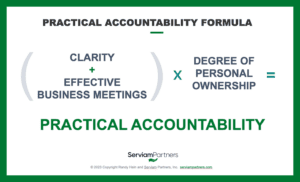By Randy Hain
A common and pervasive challenge with leaders I encounter each week is their frustration with the lack of consistent accountability from their teams. We acknowledge it is a problem, but we typically struggle to address it in practical and meaningful ways. Maybe there is a great book out there with all the answers? A quick Amazon search for books on this topic yielded over 30,000 results! That feels a little overwhelming and it can be difficult to even know where to begin. Perhaps we should start by keeping it simple and practical.
How do we define accountability?
Accountability for a team member means accomplishing the things you said you would do. It’s about taking personal responsibility for your work. It’s also about trusting in your teammates, holding each other accountable and knowing you can count on each other to get things done. A leader has the same responsibility as their team members, but also to hold others accountable. When a leader tolerates missed deadlines and incomplete work on a regular basis, these behaviors become the norm for the team. This lack of accountability has a ripple effect that negatively impacts performance and morale on the team.
What are the obstacles to improving accountability?
In my experience, one of the most significant obstacles to improving accountability is status quo thinking, or doing something because that is the “way we have always done it”. I have written before about “normalized defects” in business and many of the issues I would associate with lack of accountability come from negative behaviors or mindsets I think we acknowledge sometimes exist in our companies, but are allowed to remain: lack of candor, lack of trust, dysfunctional business meetings, unclear communication, groupthink, confusing strategy, fear of failure, lack of role clarity, etc.
Another significant obstacle is our tendency to over complicate our thinking about accountability. It is clear from my brief Amazon book search and years of experience that there are countless ideas out there to combat the problem. Teams and entire organizations can have systemic accountability issues that may require grander approaches, but the leaders I know who want to address this are looking for helpful and easy to use best practices they can implement now.
I would like to offer you an approach called the Practical Accountability Formula that is practical, simple and clear. Mastering and consistently implementing this formula will yield immediate results. It will require self-awareness, self-discipline and a willingness to change old habits.

Clarity. It is a leader’s responsibility to communicate and lead with clarity at all times. Leaders should always be clarifying the why, who, what and when in every aspect of their daily work. Leaders should help clarify the roles and responsibilities of their team members. Leaders should hold teams accountable to specific deadlines for work to be completed and communicate the positive and negative consequences for making or missing these deadlines. Vagueness and ambiguity are the opposite of clarity and lead to confusion and ineffective results. Good leadership creates clarity, not confusion. Also, remember that clarity is not only the responsibility of senior executives. Each of us has a responsibility to model clarity, regardless of our role or title. Helpful Tip: If you are looking to develop your level of clarity more fully, I strongly encourage reading my post Clarity Matters.
Effective Business Meetings. Unnecessary and unproductive business meetings are a common problem in most companies and this contributes directly to challenges with accountability and wasted time as these ineffective meetings often take up time that could be better utilized for more important work. Some business meetings are clearly necessary, but we can do better. Missing agendas, inability to define the tasks to be completed, lack of clear task ownership and unclear deadlines for work to be completed along with a failure to assign someone to take notes to recap and share important information from meetings are at the heart of this issue. Addressing this is critical to improving accountability as business meetings are the most common vehicle (and the easiest opportunity) for a leader to share clear expectations, review the work to be discussed/assigned and deadlines to be given. Helpful Tip: If you are looking to greatly improve the effectiveness of your business meetings, I strongly encourage reading my post Fixing Dysfunctional Business Meetings and the best practices it contains.
Personal Ownership. This is the “X factor”. In my experience, most teams have at least one person who naturally and consistently takes ownership when needed and is willing to be held accountable for results. Most leaders likely achieved their positions partly because of a consistent ability to do this well. How about other team members who are reluctant to step up and accept responsibility or place their names next to tasks and projects with clear deadlines? What keeps them from showing more ownership? Fear? Lack of commitment? Trust issues? It is the job of a leader to understand why and the job of team members to embrace the importance of stepping up. Improving personal ownership for team members is both a self-development opportunity for them and an excellent coaching opportunity for their leaders. You can have amazing clarity and the world’s most effective business meetings, but overall accountability for results will thrive, move slowly or potentially fail based on the degree of personal ownership exhibited by each team member. I am reminded of the advice I received early in my career from a wise mentor: “If you touch it, you own it. Even if you only have 1% of the actual problem/issue, act as if you have 100%. If we all act this way our work gets done faster and our problems will quickly be solved.” When used with discernment, a collaborative mindset and good judgment, this is invaluable advice.
Each of these components of the Practical Accountability Formula are dependent on the other and exist on a continuum. For example, if you rated your leadership clarity as an 8 of 10, the effectiveness of your business meetings as 7 of 10 and personal ownership from the team as 7 of 10, you would generally have solid overall accountability for results from the team. In comparison, lower scores in each area negatively impact accountability. It is interesting to note that if there is zero personal ownership from the team, this results in zero accountability as anything times zero = zero. This is why I described it as the true “X factor” earlier in the post and a true coaching opportunity for leaders to drive improvement.
It is also important to note that if we follow the simple definition I shared at the beginning of the post, we have a shared accountability to each other on the team, not just for our individual tasks. Our willingness to be held accountable and do our jobs well directly impacts every other member of the team, the team’s overall performance and that of the company. Accountability is both an individual goal and a commitment to our colleagues.
I hope you are willing to embrace this practical and simple approach as a way to begin moving the needle on accountability. The leaders and teams I know who follow it have experienced great results. If you are a leader at any level of your organization, here is a helpful first step to help you implement the Practical Accountability Formula:
For your next team meeting…
- Create and share in advance an agenda that clearly spells out the purpose of the meeting, what you will discuss and the deliverables/commitments you wish to see at the end of the meeting. Send any pre-reads or requests for pre-work to be done in advance of the meeting to make sure everyone is well-prepared. Make it clear that accountability with clear ownership and real deadlines for solutions are the goal for the meeting.
- Remind everyone at the beginning of the meeting that this is a psychologically safe place and ask everyone to be respectfully candid. Also, make it clear that silence equals consent and this meeting is the best opportunity to voice opinions.
- Ask someone to be the scribe for the meeting and take notes of what is discussed, with an emphasis on writing a recap of the issue discussion and identifying who owns the solutions and their deadlines. These notes should go out within 24 hours after the meeting to all participants.
- Identify and reach consensus on the problem(s) to be addressed. Be able to clearly identify why it is a problem, why this team is responsible for solving it and the consequences to the business if it is not solved. Have some time allotted (20-30 minutes) for discussing the issue(s) to make sure everyone understands and is on board with what needs to be done.
- Ask for volunteers to take ownership for solving the issue or elements of the issue based on size/complexity. If nobody volunteers, assign who you think the best person is to tackle the issue/task.
- Ask each person given task ownership for a firm date commitment on when they expect to have the task completed or issue solved.
- End meeting with a clear understanding of the issue, who in the room owns solutions or pieces of the overall solution and exactly when the work is to be done. The scribe should have all this captured in the notes/recap which goes out to everyone.
If your bonus/compensation plans allows for this, one way to drive greater accountability is to share that team members who hit their metrics/goals AND who consistently take ownership and show accountability for getting results in these kinds of team discussions will have a greater chance of hitting or exceeding their bonus potential. Share that what each team member does with ownership and accountability will be an ongoing part of all Quarterly performance reviews.
The leaders I know who excel at driving accountability are positive, motivational and inspirational in their approach with the team. It is of vital importance for improving accountability that leaders raise their expectations regarding commitments on deliverables from their teams without over indexing on negative consequences. Find an approach that works for you. Be consistent and fair with how you apply this with the team.
If you are ready to stop talking about accountability and start making real progress, this post was written for you. This is part of a brand-new series of group sessions my colleagues at the Leadership Foundry and I are developing for our clients and I hope you find it helpful.
Thanks and good luck!







